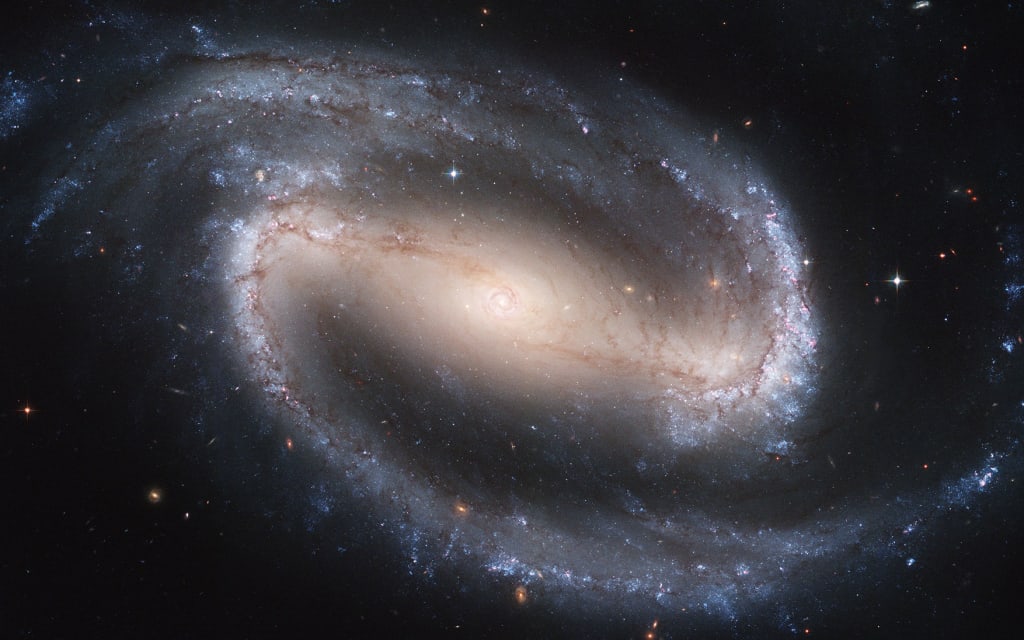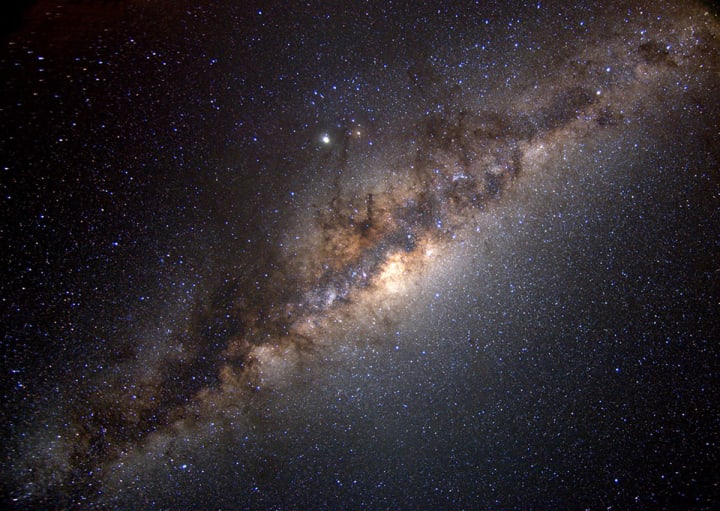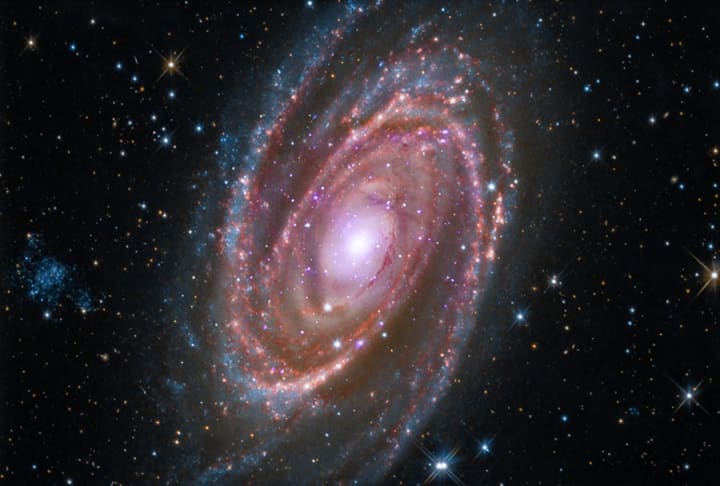Galaxy Guide
Like stars and snowflakes, no two galaxies are ever alike. But the interest in galaxies is similar throughout science.

What is a galaxy? It is the largest kind of star group or system in the universe. Our Sun is a member of such a star system, along with several hundred billion other stars. The name of our galaxy is the Milky Way.
Astronomers estimate that there are around a billion other galaxies scattered throughout the visible universe. Although not all galaxies have the same number of stars in them, you can get an idea of how many billions of stars there are in the universe. Do you know how big a billion of anything is? You will not have lived one billion seconds until you are about 33 years old.
The Andromeda Galaxy is named after the constellation in which it appears. It is one of the very few galaxies that can be seen from the Earth without a telescope. But it is so far away that only with the largest telescopes can some of the brighter stars in it be seen. The Andromeda Galaxy is two million light years away, meaning that the light that we see coming from this galaxy has been traveling through space for two million years.

Photo via A Picture of the Day
Inside the Milky Way
Astronomers are quite sure that the Milky Way looks very much like the Andromeda Galaxy. But we cannot see the Milky Way in the same manner that we view the Andromeda Galaxy because we are inside of it. It would be like trying to take a picture of your house while you were sitting in your bedroom. However, if you looked out of your window, you would be able to see the other houses around you and get an idea of the shape of your own house. In the same way, from many observations and studies of other galaxies as well as our own, astronomers have a good idea of what the Milky Way looks like.
If we could get outside the Milky Way and view it from above, it would look like a giant pinwheel with its long arms spiraling out from its center or nucleus. For this reason, the Milky Way is called a spiral galaxy. The Andromeda Galaxy is also a spiral galaxy. From the side, the Milky Way looks like two Frisbees or platters stuck together. The plane of the galaxy is where the rims of the platters touch each other. The Sun (and the solar system) is located along this plane but not near the center of the galaxy. It is way out near the edge.
Because we are located within the Milky Way, when we view the sky from the Earth in a direction away from the plane of the galaxy, we see few stars. We are looking along the thinnest part of the galaxy. But when we look along the plane, the number of stars becomes so great that all we see with the naked eye is a faint, whitish, rather ragged band cutting across the entire sky.
This band is what the ancient peoples called the "pathway of the gods" or the "Milky Way." We must be careful not to confuse this white band that we see in the sky with our galaxy itself. Both have the same name but they are not the same thing. With a small telescope or a good pair of binoculars you can see separate stars in the Milky Way area of the sky. As you look at the hundreds of stars, remember that no one knew they existed before about 1600. Even Columbus and the other early explorers of the world had no idea that the "milky" path in the sky was actually hundreds and hundreds of stars very close together. And none of these people would have believed that the Milky Way they saw in the sky was the central plane of a vast star system which had several hundred billion stars in it.





Types of Galaxies
The Milky Way and the Andromeda Galaxy are called spiral galaxies because of their spiral arms and pinwheel shapes. However, other spiral galaxies may appear quite different. For one thing, the appearance of a galaxy depends upon the angle from which we view it. Even if we could view all the spiral galaxies from above their nuclei, we would still find great differences in their structures. The spiral arms can be very tightly wound, as in the Andromeda Galaxy, or they can be more open, as in the Whirlpool Galaxy. In some galaxies the nucleus is big and bright while in others it is very small and compact compared to the arms.
Some spiral galaxies have bar-like structures running through their nuclei. Their spiral arms start at the ends of these bars and again can be either tightly or loosely wound around the nucleus. Not surprisingly, these galaxies are called barred spirals.
Spiral galaxies range in size from about 20,000 light years to more than 100,000 light years in diameter. A light year is about 9 trillion kilometers. The Milky Way and the Andromeda are two of the larger spirals. But even the smaller ones have at least a billion stars in them and many have billions more.
A second type of galaxy is called an elliptical galaxy. These galaxies look like spiral galaxies without their arms. Some are round in shape while others are oval or elliptical.
There are more elliptical galaxies than spirals but most of them are very small and dim and cannot be seen at great distances. For this reason, spirals represent more than two-thirds of the 1,000 brightest galaxies in the sky. The small dwarf ellipticals, the most common type of galaxy, can be as small as 5,000 light years in diameter. At the other extreme are giant ellipticals with 10 times the luminosity of the Andromeda Galaxy. These giants are several hundred thousand light years in diameter with a hundred times more stars than are in the Milky Way.
There are very few dust particles in elliptical galaxies. Since stars are believed to form from such matter, no new stars are forming in these galaxies. Most of the stars in ellipticals are older ones, formed billions of years ago. The nuclei of spiral galaxies also contain very little dust or gas and very few young stars. It is in the spiral arms that we find the dust and gas necessary for the formation of new stars. It is here that we find the young stars, many of which are extremely bright and magnificently light up the curves of the arms.
The third type of galaxy is called an irregular galaxy. These galaxies don't resemble either spiral or elliptical galaxies. Their odd shapes can be caused by the collision of two galaxies or by the gravitational effect of some nearby galaxy. Two such irregular galaxies are small satellites of the Milky Way. They are the Large and Small Magellanic Clouds, named after the famous explorer Magellan after he sighted them on his round-the-world voyage. These galaxies cannot be seen from the northern hemisphere.
Like the whitish band in the sky which we call the Milky Way, the Magellanic Clouds also appear as large fuzzy patches in the sky. That is why they are called "clouds," although even astronomers of Magellan's day knew that they were not clouds like those in the Earth's atmosphere. It should also be remembered that Magellan did not discover these objects. They were well known to the many tribes that lived south of the equator long before Magellan and his crew ever sighted them.
Most of the billions of galaxies in the universe can be identified as one of these three types of galaxies—spiral, elliptical, or irregular. Astronomers do not know why some galaxies developed spiral arms or bars through their nuclei or why others became oval or round in shape. They do know, however, that the galaxies are not spread evenly over the billions of light years of space but rather are grouped into clusters. These clusters of galaxies are held together by the gravitational attraction of the galaxies on each other.
Galaxies in Groups
Our galaxy—the Milky Way—is a member of a small cluster of galaxies called the Local Group. It has about two dozen members spread over a region of around three million light years in diameter. The Milky Way and the Andromeda Galaxy are the biggest members in the Local Group.
The Local Group is a relatively small cluster. Others, such as the Virgo Cluster, have thousands of members. As with some of the galaxies, the clusters are named after the constellation in which they appear. All types of galaxies are represented within each cluster.
There are several clusters of galaxies within 250 million light years. They are close enough for telescopes to reveal the shapes of individual members. But beyond these relatively nearby clusters lie many large ones which, because they are so distant, appear very compact. Their individual galaxies look almost like stars clustered together. However, these galaxies are as far apart from each other as are those in the Local Group or other nearby clusters.
Some astronomers believe that there is evidence that the nearby clusters of galaxies form a "supergalaxy." There are about 65 clusters within 50 million light years of the Local Group and most of them lie on or near the same plane, similar to the way that most of the stars in the Milky Way lie on or near the galaxy's plane. Most of the galaxies in this huge, flat supergalaxy are also flattened like our own galaxy and the flattening appears to be in the same direction as that of the supergalaxy. If it exists, it would have a diameter of some 100 to 200 million light years with its center in the direction of the constellation Virgo where the Virgo Cluster is. It is possible that clusters of galaxies beyond this local supergalaxy also are grouped into supergalaxies.
Beyond most of the galaxies and clusters of galaxies that can be detected astronomers have found the quasars. These mysterious objects look like stars in a telescope but they emit enormous amounts of energy, far more than the average star. In fact, they may be giving off more than 100 times the total energy of all the stars in the Milky Way. But they are very small objects of only about one light year in diameter.
We don't know exactly what the quasars are but we do know that the energy we receive from them started out billions of years ago to travel toward us. We see the quasars as they were when that light left them, not as they may be today. It is thought that perhaps they are the extremely bright centers of very young developing galaxies. It is possible that in the early stages of the universe there may have been quasars in our neighborhood of space also. We don't find any quasars near us now. Perhaps the Milky Way was quasar-like in its early stages also. If the light from that early Milky Way left here billions of years ago, perhaps some astronomers within the most distant galaxies from us are now seeing that light and therefore seeing us as a quasar.
About the Creator
Futurism Staff
A team of space cadets making the most out of their time trapped on Earth. Help.






Comments
There are no comments for this story
Be the first to respond and start the conversation.